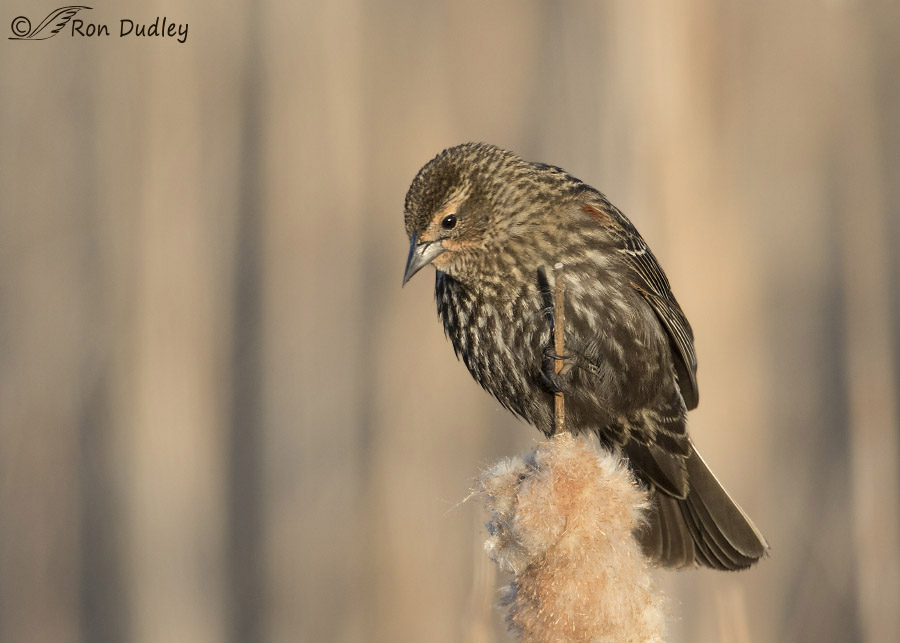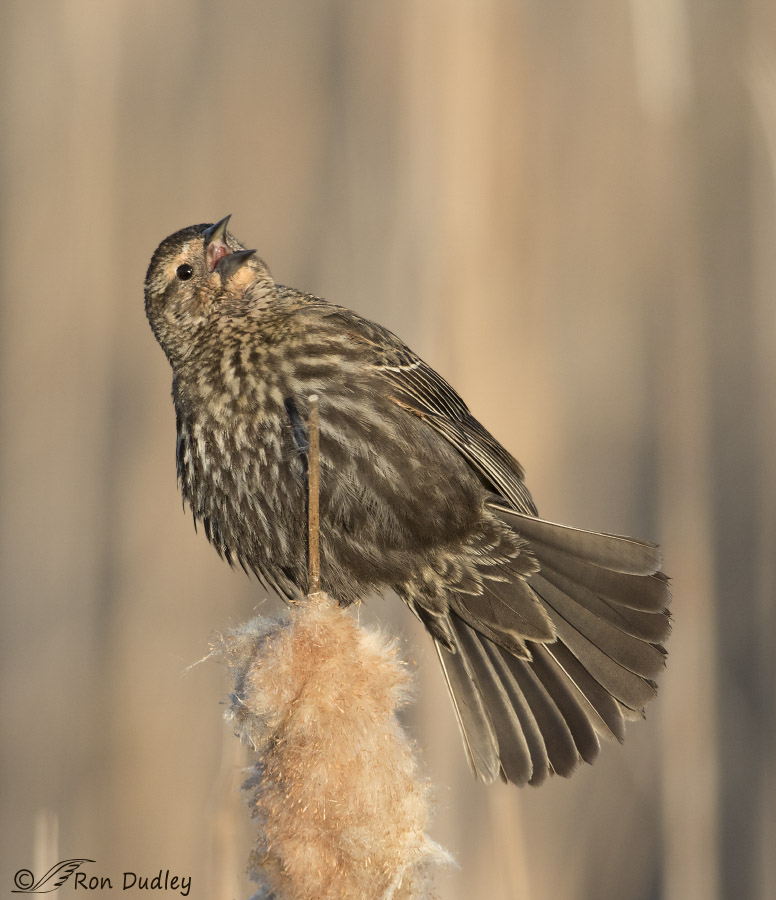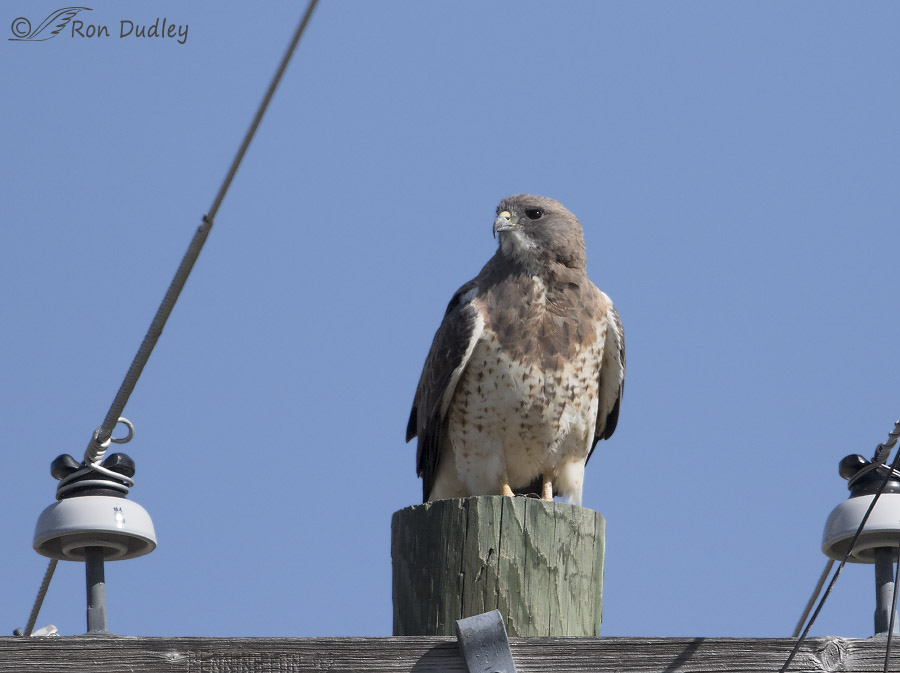Today’s post is part of my continuing effort to occasionally feature the more “common” species.
Male Red-winged Blackbirds are so distinctive in color and pattern as to be instantly recognizable by most but the mottled brown female often goes unrecognized or even mistaken for a large sparrow.
 1/1600, f/6.3, ISO 800, Canon 7D Mark II, Canon EF500mm f/4L IS II USM +1.4 tc, not baited, set up or called in
1/1600, f/6.3, ISO 800, Canon 7D Mark II, Canon EF500mm f/4L IS II USM +1.4 tc, not baited, set up or called in
I found this one yesterday morning at Bear River MBR and photographed her for several minutes as she hopped from one cattail perch to another. I like the demure pose and the similar peachy colors in the bird’s face, cattail and background.

1/1600, f/6.3, ISO 800, Canon 7D Mark II, Canon EF500mm f/4L IS II USM +1.4 tc, not baited, set up or called in
Males often perform their “song spread” display almost continuously in the springtime but females do it too, though their performance is less exaggerated than that of the male. Here the female is singing and displaying and I like the somewhat unconventional pose and the even light on the entire underside of the bird.

Regular readers may recall how much I look forward to the return of the Swainson’s Hawks in the spring after they’ve spent the winter in South America. I photographed my FOY (first of year) Swainson’s yesterday near Corinne, Utah and though it’s a crappy image for several very obvious reasons I decided to include it for documentary purposes.
I can now look forward to photographing Swainson’s Hawks for many months. I’ve missed them a lot during their absence.
Ron
PS – I can’t help but note the visual irony of the “Pennington 92” stamped on the wood of the pole’s crossbeam at lower left because it so resembles a typical image copyright watermark that I always include on my photos. It doesn’t take much to amuse me…


So glad you found this bird, and shared your photo. I have never seen a Peachy Red Wing. Beautiful bird.
Thanks, Jean. Notice that she does have a small and inconspicuous patch of red on her wing, most easily seen in the first shot.
I have a particular fondness for the LBJs. Often unappreciated, and almost always very, very beautiful when I take the time to look. Understated charm – but charm just the same.
Just the same, any of the raptors make my heart sing.
LBJ’s and britches, EC. I know you…
It sounds kinky when you put it like that. You are right though. Love them both.
A little occasional kinkiness is good for the soul, EC. At least that’s my theory…
That second shot of the not-soBlackbird is fabulous. I can almost hear her singing.
I CAN hear her singing, Arwen. Thank you.
Ron, thank you so much for you photograph of the female Red Wing Blackbird. I had no idea there was such a difference in the two. I get many Red Wings at my feeder and to be honest I thought the female looked the same. And yes I thought I had some large Sparroes. Do they go by the same name? Have a Happy and peaceful Easter.
Debbie, yes, both sexes go by the same common name. Thank you.
HAPPY EASTER AND PASSOAVER EVERYONE!!!
Same to you, Patty. And to everyone else here too…
Does look like a big sparrow. Beautiful shots! Look forward for more Swanson’s hawk!
Thank you, Tin Man.
Wonderful shots Ron, thanks for sharing!
Charlotte
Thanks, Charlotte.
The female Red-wing Blackbird is beautiful. I’m sure I would not recognize one if I saw it. I had an experience of what looked to be a large sparrow that flew into the picture window of our house when I was living in the east, and it turned out to be a female Rose-breasted Grosbeak – a bird that only migrated through our area. I think we would do well to pay more attention to the seemingly drab females of some of these species. They are beautiful in their own right. I also like the way the cattail matches the bird’s colors and the pose in the second photo. We have seen at least one Swainson’s this year. I’m always glad to see them. Since I have no ability to photograph them well, I will definitely be looking forward to seeing the photos you post.
“I think we would do well to pay more attention to the seemingly drab females of some of these species.”
Susan, there’s actually some species where I prefer the more subtle beauty of the female over the garish colors of the male – the Northern Cardinal is an example.
Good Morning, Ron!! I love the female Red-wing Black bird photos!! At our Green Cay Nature Center in Boynton Beach, FL the Male Red wing Black bird is the friendliest bird that we see on our walks. I would be one of those who would think the female was a sparrow!! I’m glad you’ve introduced me to her & will watch for her in the future. Happy for your 1st sighting of the Swainson’s Hawk – it’s a wonderful feeling to see old friends return to the neighborhood!!
And good morning to you, too, Jo Ann. I’m glad that you’ll now be able to recognize the female when you see one!
Don’t I WISH we had the Yellow-headed Blackbirds…ours are the Red Wing variety; sleek and black with red and gold (yellow) shoulder patches (would have said epaulettes, but don’t know how to spell the darned word and god knows what the evil iPad would do with that one)… Grackles are vocal, voracious feeders, scare away and compete with native birds for food and nesting sites. They can often be seen in large numbers, striding across lawns and fields, hunting for bugs and grubs.
I notice that you changing F stop, even as high as F9, any particular reason instead of lightings?
I’d have to know which images you’re referring to in order to answer your question, Steven. Both of these blackbird images were taken at f/6.3. But in general I often change f/stop as a depth of field and/or shutter speed adjustment.
A couple of days ago you used an F9. I’ve been trying different F stops, since I started to read your blog.
I assume you’re referring to the first image of a displaying grouse in this post:
https://www.featheredphotography.com/blog/2015/04/03/sage-grouse-and-fence-collisions/
I went to f/9 for that image because I was quite close to the bird and I wanted enough depth of field to get both the front of the grouse and its tail feathers sharp.
Thank you, reading your post I’m learning, really helpful and appreciate it.
Nice monochrome…that kind of blackbird is new to me…we have the hoarser calling kind, too..in the Spring,.they arrive with the Grackles and Starlings, then go their separate ways to the swamps and wet places , usually where phragmites and cat-tails grow. They come in big, mixed flocks, tank up on suet, hang around for a few days, then off they go. The grackle and Starlings stay behind, clean us out of seed and suet, make a huge racket, and poop all over everything, especially the car windows. If we hadn’t raised a Grackle many years ago, I’d probably hate them!
Patty, I’m assuming that your “hoarser calling kind” is the Yellow-headed though I thought they were pretty uncommon back east. We almost never saw grackles around here until a few years ago but now they’re pretty common.
Ron, I did not know the female RWBL displayed. And sang. The ones I see in our yard just eat and call hoarsely. Thanks for the lessons and of course the wonderful picture of Mrs.
Diana, the female performs several of the display behaviors that are most commonly associated with the males but her behaviors are most often directed at other females, rather than males. Thank you.
Great shots of both hawk and Redwing. I’ve been trying for a female Redwing with very little luck. These are wonderful shots! Envy!!!
Dick, I think the females are more difficult to photograph because they tend to spend most of their time skulking low in the vegetation rather than out on conspicuous, high perches like the males. Thank you.